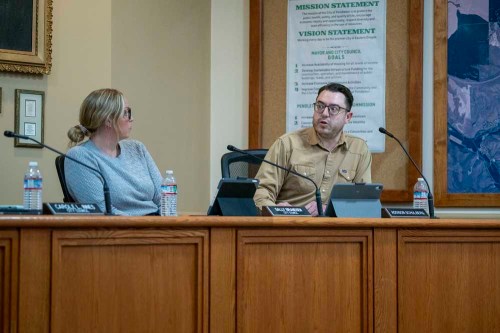Pendleton City Council passes historic district sign ordinance
Published 6:00 am Friday, November 22, 2024

- Pendleton City Councilor Addison Schulberg questions details in the proposed sign ordinance during the council's Nov. 19, 2024, regular meeting.
PENDLETON — New businesses in historic downtown Pendleton will have to meet updated signage standards after the Pendleton City Council unanimously passed an ordinance.
During its regular meeting Tuesday, Nov. 19, the council approved a proposed ordinance that applies to the city’s historic district on and around Main Street. The new ordinance will require dimmed lights after 11 p.m. or after a business closes, mandate that neon be included in certain signs, and impose a limit on the type of signage allowed in the district.
Trending
The version of the ordinance councilors passed excluded some of the language the Pendleton Planning Commission had suggested, including the number of signs per building, how to define a building, and language pertaining to murals.
The decision comes after about two years of work, said city planner Julie Chase. The planning commission passed the proposed ordinance earlier this month and commission president Joseph Hull, among others, spoke in support of the ordinance during the public hearing portion of the meeting.
“I feel like we’ve gone completely through the program,” Hull said. “I feel we’re at a very fair spot here, and I would encourage you to approve the ordinance.”
However, local business owner Jordan McDonald criticized the language limiting signs to three per building. He said his building, St. George Plaza, has eight storefronts representing individual businesses.
No limit to signage
In section 7.02.9, the ordinance says a building is defined by a firewall, but in a bullet point below that, it says a “building, regardless of firewall separations,” cannot have more than three signs. Council members took issue with the contradictory wording in the proposal.
Trending
“The way that (the ordinance is) written, and that I understand it, is that it doesn’t matter how big your building is, whether it’s 50 feet wide or whether it’s 324 feet wide, you’re restricted to three signs,” McDonald said. “And as a property owner that has eight commercial businesses on the first story of our building, we would be in a situation where if one tenant left — which is common, it’s unfortunate — but if they closed their business and took down their sign, this ordinance would not allow more than three signs at the building.”
Limiting a building to three signs would restrict incoming business owners in a shared building differently from those in a stand-alone building. It could also require combining signs for multiple businesses or prevent a business from posting a sign at all.
City Councilor Addison Schulberg, among others, said that seems unfair.
“Just by virtue — or by demerit, in this case — of them having rented space in a building with multiple storefronts, they would now all of a sudden be subject to a far, far stricter ordinance,” he said. “And to a passerby or a potential customer or somebody coming down to the historic district, we don’t look at buildings as individual buildings and the barriers in the same way that they’re being delineated herein.”
Instead, Schulberg said, the average person “reasonably” delineates the buildings by business.
“Each of those businesses, I think, should be subject to the same rights and restrictions in the ordinance,” he said.
He proposed striking the limit of three signs per building, regardless of firewalls. Schulberg made the motion to approve the ordinance with certain changes, and Steve Campbell seconded it.
The council agreed. It unanimously voted for the motion to remove the phrasing of three signs per building, meaning businesses and buildings will not have to limit their number of signs at all. In the same motion, the council also voted to remove the entire section focused on murals, as some members indicated concerns about restricting content.
The language about murals will come back before the council at a future meeting.









